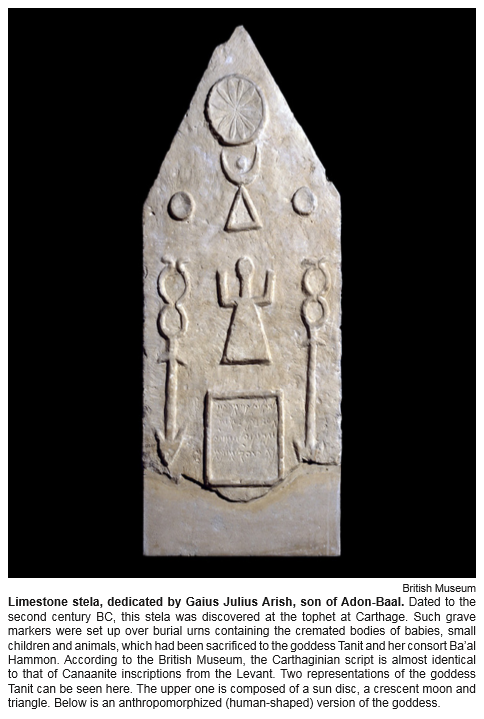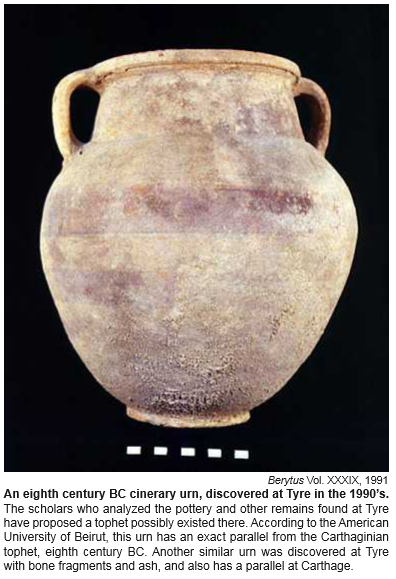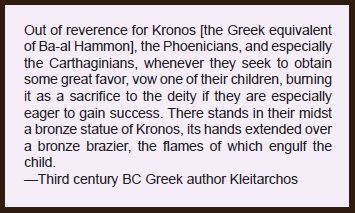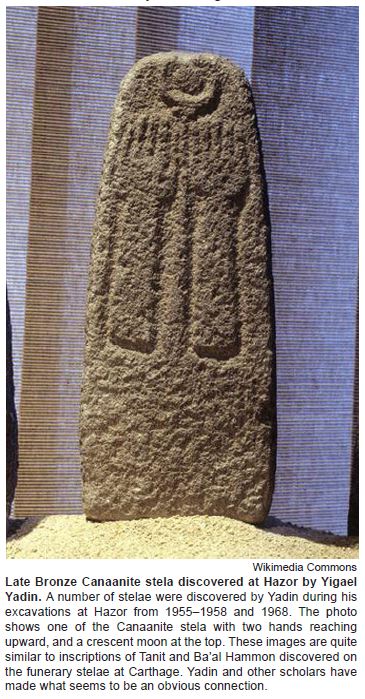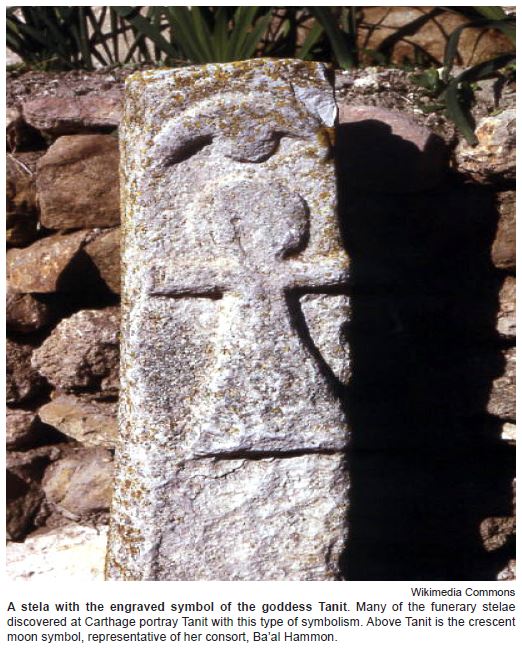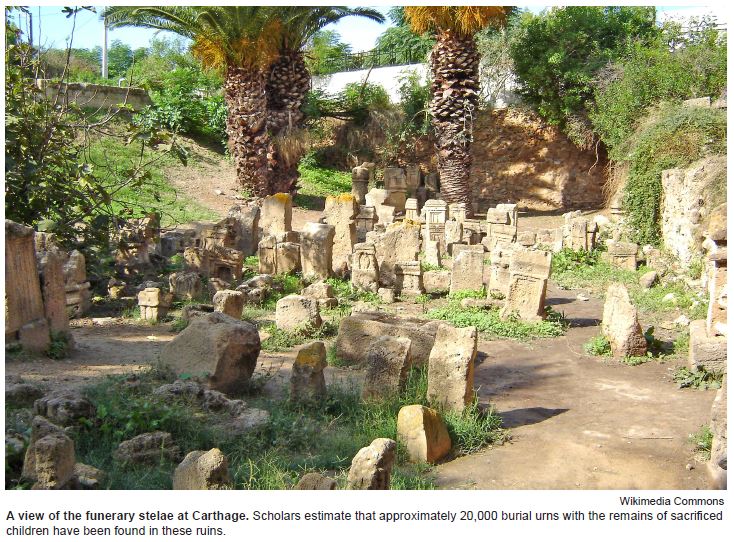Introduction
The ancient city of Carthage, North Africa (modern Tunisia), began as a fledgling Phoenician colony, and grew into one of the most prosperous and prominent city-states of the ancient world. Its influence and role in central Mediterranean history is often obscured by the legacy of the Greeks and the Romans. Well known for exporting expensive purple dye, they are also known for resisting the Romans during the Punic Wars. Hannibal, the infamous Carthaginian military commander, was a nemesis of Rome for several decades. Most notably, Carthage has the ignominious reputation for performing large scale child sacrifice over a period of several centuries.
Carthage was settled by the Phoenicians in the middle of the ninth century BC. Exactly how they got to North Africa is somewhat obscure. More certain is their place of origin: the Lebanese coast of Canaan. This region was considered Canaanite during the second millennium BC. Near the beginning of the Iron Age (1200 BC), the Phoenicians had taken control of this region. Scholars call the Lebanese coast Phoenicia, the name given to the region by the Greeks, from their word for “purple.” The ancient world’s purple dye industry developed from extracting a fluid from a Mediterranean mollusk, the murex. Not only did the people of the Phoenician coast develop this industry, they specialized in shipping this very valuable commodity all over the Mediterranean world. There are many connections between Israel and the Phoenician territories, most notably, the cities of Tyre and Sidon.1
Like any nation which inhabits a new region, the Phoenicians brought their ancestral Canaanite beliefs and practices with them when they settled at Carthage. Several lines of evidence demonstrate that one of these distinctive practices was child sacrifice. Numerous biblical texts refer to this horrific Canaanite practice. One of the earliest references is found in Deuteronomy 12:31: “You shall not worship the LORD your God in that way, for every abominable thing that the LORD hates they [the Canaanites] have done for their gods, for they even burn their sons and their daughters in the fire to their gods.” Later, God condemns his people for sacrificing their own children to the gods of Canaan in the Hinnom Valley on the south side of Jerusalem (Jer 7:30–32).
The open air sanctuary was known as the Tophet, which is typically translated as “roaster” or “place of burning.” Modern scholars have given the name tophet to places where they believe child sacrifice took place around the Mediterranean rim, mostly famously at Carthage. We believe it is apparent that the Phoenicians brought this barbaric practice to Carthage from Canaan, and therefore, evidence of child sacrifice at Carthage provides support for the historicity of the biblical accounts which mention such sacrifices. Even though Carthage is geographically removed from Canaan (approximately 1400 mi distant), it is not religiously or ancestrally removed.
In the past 30 years or so, several scholars have attempted to discredit or diminish the historicity and/or extent of the practice of child sacrifice at Carthage. The implications from this line of argumentation are somewhat obvious for biblical studies: if one can discredit the historicity of child sacrifice at Carthage and its ancestral connections to the same type of barbaric practice in Canaan/Phoenicia, then one might argue that the portrayals of child sacrifice in the OT are fictitious or exaggerated. This issue of Bible and Spade will explore some of these arguments, and outline the significant evidences for the reader. They include evidence from biblical texts, the testimony of ancient historians, and archaeological evidence. We believe the connections are extremely powerful, convincing...and sobering.
The Critics
In an attempt to restore the historical reputation and heritage of his country, Tunisian scholar M’hamed Hassine Fantar has vociferously argued that charges of Carthaginian child sacrifice are “propaganda.” Because Carthage was definitively defeated and destroyed by the Romans in 146 BC, Fantar contends that the Romans distorted history “to show us as barbarians... to justify their own barbarity.” Roman historians he considers to be more credible, such as Polybius and Livy, do not make mention of these practices at Carthage. This demonstrates, in Fantar’s estimation, that child sacrifice did not take place there. Such is Fantar’s influence that tour guides at Carthage are being instructed to deny child sacrifice took place there. Fantar has also argued that the extensive child burials unearthed at Carthage occurred because of notoriously high infant mortality rates in antiquity.2 Italian scholar Sergio Ribichini supported Fantar’s contention, stating that the tophet at Carthage was “a child necropolis designed to receive the remains of infants who had died prematurely of sickness or other natural causes, and who for this reason were ‘offered’ to specific deities and buried in a place different from the one reserved for the ordinary dead.”3 Thus, in finding some support from other scholars, Fantar concludes:
Carthaginians did not sacrifice their children to Ba’al Hammon in the Tophet. This open air site...was a sanctuary presided over by Ba’al Hammon and his consort, Tanit...To this sanctuary came grieving parents, who gave their children back to Ba’al Hammon and Tanit.4
Harvard archaeologist Lawrence E. Stager has argued against Fantar’s position for many years in various forums, primarily as a result of his excavation work conducted at Carthage in the 1970’s under the auspices of the University of Chicago’s Oriental Institute.5 His most widely circulated work is the article he co-authored with Samuel R. Wolff in the Jan/Feb 1984 issue of Biblical Archaeology Review, entitled: “Child Sacrifice at Carthage: Religious Rite or Population Control?”6 This extensive article lays out the evidence for Carthaginian child sacrifice, and makes several connections to Phoenicia’s geographical roots in coastal Lebanon and its religious roots in Canaanite cultic practices and beliefs. This important issue of Bible and Spade will partially draw on the extensive research conducted by Stager and his team.

Our study emphasizes that historical scientists must consider all evidence when deciphering ancient societal behavior. The idea of regular infant sacrifice in Carthage is not based on a study of the cremated remains, but on instances of human sacrifice reported by a few ancient chroniclers, inferred from ambiguous Carthaginian inscriptions, and referenced in the OT. Our results show that some children were sacrificed, but they contradict the conclusion that Carthaginians were a brutal bunch who regularly sacrificed their own children.
Schwartz and his team thus concluded, “very young Punic [Phoenician]7 children were cremated and interred in burial urns regardless of how they died.” Schwartz also claims that his team disproved the commonly held theory that only firstborn males were sacrificed. His team’s study of pelvic bones from the burial urns from the Carthage tophet proved that “38 pelvises came from females and 26 from males.”8
Brief Critique of Schwartz by the Editors of Artifax
There is much that is wrong with Schwartz’s conclusions. First, Schwartz and his team admit, “some children were sacrificed.” He is thus forced to argue that the tophet at Carthage contains a mixture of both sacrificed babies and unsacrificed babies that died natural deaths.
Schwartz also fails to explain why adults and older children, who are known to have died natural deaths, are not found in the Carthage tophet, or for that matter in any other tophet that has been discovered. Incidentally, the OT indicates that the bones of non-sacrificed humans could be used to religiously defile a tophet (2 Kgs 23:14).
Second, Schwartz’s conclusion that the Carthaginians did not regularly practice child sacrifice is based upon “26 individuals (who) died prenatally or within two weeks of birth.” Schwartz’s evidence could and probably should be interpreted as meaning that about half of the children sacrificed in the tophet at Carthage were newborn infants. In addition, his “26 individuals” out of the 50 studied may have included live-born infants who were born prematurely. Schwartz stresses the possibility that some of these 26 might have been stillborn infants, but his own scientific evidence does not prove that they were.
Third, as Schwartz’s press release indicates, a small minority of urns in the Carthage tophet contains the bones of cremated sheep. These were unquestionably animals offered as religious sacrifices. The very presence of these sacrificed animals very strongly suggests that the tophet at Carthage was only used as burial site for victims of religious sacrifices.
Fourth, Schwartz and his team concluded, “very young Punic children were cremated and interred in burial urns regardless of how they died.” There is no indication in his press release that Schwarz and his team ever determined scientifically how these babies died. He argues with very faulty reasoning: some babies may have been prenatal, some were therefore probably stillborn, and hence some were not sacrificed.
Fifth, it has long been known that the infants found in the tophet at Carthage were both male and female, and thus Schwartz’s team does not provide any truly new information on this subject. However, the fact that Schwartz’s study identified 38 females and only 26 males in 70 studied urns from the Carthage tophet may be significant. It suggests that the Carthaginians may have practiced some sort of selection process. If so, it would disprove Schwartz’s conclusion that most of these infants died natural deaths.
And sixth, Schwartz too lightly dismisses historical evidence from Greek and Roman sources, and also from the OT. This historical evidence clearly indicates the extensive practice of child sacrifice by the Carthaginians/ Canaanites/Phoenicians, and also by the Israelites. The OT is particularly valuable because it clearly relates that tophets were religious sites that were originally larger and much more than just cemeteries for cremated babies.
Archaeological inscriptions mentioning Carthaginian deities and engravings of a religious nature found in the Carthage tophet provide strong support for the OT’s depiction of tophets as sacred outdoor sanctuaries where religious rituals were practiced. Some of these religious rituals included, but were certainly not limited to, the sacrificing of babies.9
Further Considerations and Biblical Connections
The editors of Artifax have touched upon numerous problems associated with Schwartz’s and Fantar’s position(s). This section will explore these arguments a bit further, adding some additional detail and making biblical connections.
First, Fantar’s zeal to redeem his country’s reputation may be admirable, but it actually serves to undermine his case. Demeaning rhetoric concerning the Roman and Greek sources without a shred of proof to substantiate the charge is not convincing, and then selectively appealing to other Roman historians who do not mention child sacrifice is problematic at best. One can easily see this appeal is both inflammatory and an erroneous argument from silence. Nary is a mention made of the Church Father, Tertullian of Carthage, who appeared to know Carthaginian history all too well. Stager and Greene hold a more persuasive posture, writing: “Our purpose in making this case is not to malign the Phoenicians, but to understand them."10
Second, Stager and a team of other scholars have recently published an updated analysis of the cremated remains from the burial urns at Carthage. Their in-depth study indicates many of the infants died during a very limited lifespan range, militating against Fantar’s view that the tophet at Carthage was a mere cemetery filled with thousands of children who died of natural causes. They state:
...the argument for infant sacrifice depends largely on a skewed age profile, and age is not easy to determine. The authors approach this problem with a battery of new techniques, showing that in the Tophet of Carthage the majority of the infants died between one and one and a half months...The age profile of the Tophet infants is markedly different from that expected in the case of death from natural causes.11
Third, the engravings found on the funerary stelae at Carthage are devastating to the skeptical position—under the stelae are urns containing the burnt remains of the children. In particular, there is a certain Semitic inscription, mlk, which has a very close connection to the OT. Hebrew, like other Semitic languages, was originally written without vowels.12 Based on epigraphical studies by Paul Mosca,13 these Semitic inscriptions have been translated as mulk. Stager explains: “Mulk is a technical word in Semitic for a live sacrifice fulfillment of a Tophet vow, just as other Semitic words are used to indicate cereal offerings and other kinds of animal sacrifices” (emphasis added).14 This evidence directly contradicts Fantar’s contention, as the Semitic inscription mlk is compelling evidence that the children were still alive when they were brought to the sacrificial fires, corroborated by the Greek and Roman sources.15
Fourth, Stager and Wolff suggest the possibility that “the fire of Molech,” mentioned in Jeremiah 32:35 and 2 Kings 23:10, may be better translated as mulk. The same Hebrew consonants appear here in these texts as on the funerary stelae at Carthage, mlk. A mulk sacrifice most certainly refers to a living sacrifice of either a child or animal substitute. The presence of animal remains, which appear to have occasionally substituted for children, demonstrates that the tophet at Carthage was not just a cemetery.
Additionally, Jeremiah 32:35 refers to “the high places of Baal, in the Valley of the Son of Hinnom,” connecting the practice of child sacrifice to Ba’al worship.16 Hundreds of funerary stelae at Carthage are inscribed with the images of the goddess Tanit, and her consort, Ba’al Hammon, a deity of Canaanite origin. The remains of thousands of incinerated children were buried under these funerary stelae with Semitic inscriptions that refer to living sacrifices, mlk. In the OT, we find child sacrifice directly associated with Ba’al worship and with Molech, possibly mulk. Some scholars commonly identify the Ba’al of the OT as Ba’al Hadad, often hesitating to connect the OT references to the Ba’al Hammon of Carthaginian/Phoenician inscriptions. Others have argued that the references to Ba’al(im) in the plural form in the OT are references to Canaanite deities in general, leaving open the possibility that Ba’al Hammon could be in view. While we cannot be dogmatic, the totality of overall evidence certainly lends merit to such a connection.17
Fifth, an ivory plaque measuring 2 by 1.3 inches was discovered at the excavations at the Phoenician city of Sarepta (biblical Zarephath) in 1974. This discovery, dated to the seventh century BC, was reported by ABR Director of Research, Bryant Wood, in the Winter 1975 issue of Bible and Spade as follows:
In the 1971 season a small shrine dating to the Iron Age (1200–600 B.C.) was discovered at Zarephath. This was the first homeland Phoenician shrine to be found. In 1974, excavations in the shrine produced an assortment of votive objects and cultic equipment, including figurines, carved ivory, beads, masks, amulets, cosmetic equipment and saucer lamps. Among the objects found in the shrine was an ivory plaque with an inscription on it. The plaque was probably originally fastened to a wooden statue.
The four-line inscription of the plaque, written in ancient Phoenician characters, reads “This statue made (by) Shillem, son of Mabaal, son of Inai for Tanit-Ashtart.” This is the oldest reference to Tanit found to date and it identifies the shrine and cultic objects as dedicated to Tanit and another Phoenician deity, Ashtart or Astarte, goddess of fertility. Astarte [Ashtoreth] is mentioned in the Bible at a number of places, e.g. Judges 10:6, 1 Kings 11:5, 33 and 2 Kings 23:13.18
With the discovery of this inscription, a definitive connection between Tanit at Carthage and Tanit-Ashtart in the Phoenician homeland was made. Interestingly, the author of Judges put Tanit and Ba'al together hundreds of years before Carthage was even founded: “The people of Israel again did what was evil in the sight of the LORD and served the Baals and the Ashtaroth...And they forsook the LORD and did not serve him” (Judges 10:6, ESV). Later, 2 Kings 23:13 refers to “Ashtoreth, the abomination of the Sidonians.” Sidon is located about 25 miles north of Tyre in the Phoenician mainland. Again, we see strong biblical connections to Phoenicia and deities to whom children were sacrificed.
Tanit-Ashtart and Ba’al Hammon have distinctive Canaanite origins, both affirmed by archaeology. Tanit is represented on some of the Carthaginian stelae with an upraised hand(s) or triangles with extended lines and circles that represent upraised hands. Ba’al Hammon is typically represented by a disk and crescent.19 ABR founder David Livingston explains their earlier manifestations in Canaan:
Early in Canaanite religion, the male Moon-god, “Yerach,” was the chief god of the pantheon. And the female sun-god, “Shamash,” was his consort. Later, these were changed to Baal and Ashteroth.20
At Hazor, archaeologist Yigael Yadin discovered several stelae from Late Bronze I (ca. 1483–1400 BC), one of which contained the carved relief of upraised hands, along with a disk and crescent. This stela predates the Carthaginian versions by several centuries. It is fascinating to see the similarity in the designs preserved for such a long period of time. Yadin believed that the hands, disk and crescent represent the same gods, stating: “it is quite clear that the Punic culture preserved elements of the Phoenician culture, and the latter was definitively influenced by Canaanite elements, similar to the ones uncovered at Hazor.”21 This connection to the Canaanite city of Hazor provides more powerful evidence from archaeology connecting the Carthaginian deities to Canaan.
Finally, the American University of Beirut published a study in 1991 analyzing artifacts and remains discovered in Tyre that may point to child sacrifice. Of interest are two cinerary urns whose closest parallel, according to the authors, were found in the Carthaginian tophet, dated to the eighth century BC. Several of the urns discovered at Tyre contained human bone fragments, many of which appear to have been incinerated at high temperatures. Multiple stelae have been discovered and examined as well. While we ought to be cautious in drawing connections, further research may provide more definitive evidence placing an actual tophet in the prominent and important biblical city of Tyre, right in the Phoenician homeland.22
Much more could be said in making the connections between the biblical accounts and child sacrifice at the Carthaginian tophet. The Phoenicians evidently inherited this demonic practice from their Canaanite ancestors, affirming the biblical references. This issue of Bible and Spade will continue to explore those connections, and, with sober consideration, connect the practice of child sacrifice in the ancient world to the perpetuation of legalized abortion on demand in the United States in the present day. It is this subject to which I will now briefly turn.
The Bible and the Practice of Abortion
The Christian who takes seriously the authority, inerrancy and infallibility of the Bible must reckon with the obvious teaching of Scripture concerning the beginning of human life and the value God places on human beings created in His image.
Many professing Christians have taken the position that abortion is a private, personal matter, or a fetus is not human until it reaches some particular state of development, or Christians should not be focused on changing public policy with respect to abortion (after all, politics is a “dirty business”). When taken in its totality, the biblical testimony is clearly in opposition to these positions. We pray these brothers and sisters in Christ will be persuaded to change their minds on such an important matter. If you are a believer and have doubts about this assertion, please consider the following passages from the Bible (all ESV).
Conception is a gift from God23
The LORD visited Sarah as he had said, and the LORD did to Sarah as he had promised. And Sarah conceived and bore Abraham a son in his old age at the time of which God had spoken to him (Gn 21:1–2).
And Isaac prayed to the LORD for his wife, because she was barren. And the LORD granted his prayer, and Rebekah his wife conceived (Gn 25:21).
Then God remembered Rachel, and God listened to her and opened her womb. She conceived and bore a son and said, “God has taken away my reproach” (Gn 30:22–23).
...in due time Hannah conceived and bore a son, and she called his name Samuel, for she said, “I have asked for him from the LORD” (1 Sm 1:20).
But the angel said to him, “Do not be afraid, Zechariah, for your prayer has been heard, and your wife Elizabeth will bear you a son, and you shall call his name John (Lk 1:13).24
God is the Creator of the Unborn
Your hands fashioned and made me...Remember that you have made me like clay...You clothed me with skin and flesh, and knit me together with bones and sinews (Job 10: 8a, 9a, 11).
Did not he who made me in the womb make him? And did not one fashion us in the womb? (Job 31:15).
Now the word of the LORD came to me, saying, “Before I formed you in the womb I knew you, and before you were born I consecrated you; I appointed you a prophet to the nations” (Jer 1:4–5).
For you formed my inward parts; you knitted me together in my mother’s womb. I praise you, for I am fearfully and wonderfully made. Wonderful are your works; my soul knows it very well. My name was not hidden from you, when I was being made in secret, intricately woven in the depths of the earth. Your eyes saw my unformed substance; in your book were written, every one of them, the days that were formed for me, when as yet there was none of them (Ps 139:13–16).
As you do not know the way the spirit comes to the bones in the womb of a woman with child, so you do not know the work of God who makes everything (Ecc 11:5)
Thus says the LORD who made you, who formed you from the womb and will help you... (Is 44:2)25
Behold, I was brought forth in iniquity, and in sin did my mother conceive me (Ps 51:5).26
The Unborn Responds to God ...for he will be great before the Lord...and he will be filled with the Holy Spirit, even from his mother’s womb (Lk 1:15).
And when Elizabeth heard the greeting of Mary, the baby leaped in her womb. And Elizabeth was filled with the Holy Spirit, and she exclaimed with a loud cry, “...For behold, when the sound of your greeting came to my ears, the baby in my womb leaped for joy” (Lk 1:41–44).
Prohibitions Against Unlawful Killing27
“Whoever sheds the blood of man, by man shall his blood be shed, for God made man in his own image (Gn 9:6).
You shall not murder (Ex 20:13).
Then the king of Egypt said to the Hebrew midwives...“When you serve as midwife to the Hebrew women and see them on the birthstool, if it is a son, you shall kill him, but if it is a daughter, she shall live.” But the midwives feared God and did not do as the king of Egypt commanded them, but let the male children live (Ex 1:15–18).
“When men strive together and hit a pregnant woman, so that her children come out, but there is no harm, the one who hit her shall surely be fined...But if there is harm, then you shall pay life for life...” (Ex 21:22–23). (Note that the punishment in the Mosaic Law for the accidental killing of a child in the womb is death. How much more so if the child were killed deliberately!) 28
This biblical data unequivocally teaches us the following:
1. God is the Creator of all human life
2. Human life begins at conception, and all people are sinners
from conception
3. God distinguishes between children inside and outside the womb, but considers them both equally human29
4. The taking of life in the womb or outside the womb with prior deliberation (which is the case with an abortion) is tantamount
to murder
5. The fetus is to be afforded legal protection by civil authorities
6. It is appropriate to disobey civil authorities (or any other authority) if one is being ordered or coerced into unlawfully killing a child, whether born or unborn30
Some of our Christian brothers and sisters tend to focus on the fact that there is not specific mention of abortion in the Bible, and therefore, we do not have warrant to oppose it. Technically speaking, this lack of mention is correct, but the above passages certainly demolish such a superficial, intellectually lazy, and morally suspect argument. Meredith Kline deals with this objection, and summarizes thus:
The most significant thing about abortion legislation in Biblical law is that there is none. It was so unthinkable that an Israelite woman should desire an abortion that there was no need to mention this offense in the criminal code...The Middle Assyrian laws attest to an abhorrence that was felt for this crime even in the midst of the heathendom around Israel, lacking though it did the illumination of special revelation. For in those laws a woman guilty of abortion was condemned to be impaled on stakes...It is hard to imagine a more damning commentary on what is taking place in enlightened America today than that provided by this legal witness out of the conscience of benighted ancient paganism!31
Since 1973, over 53 million unborn children, image-bearers of God Himself, have perished at the secularist altar of self. Considering God’s attitude of wrathful anger towards the Israelites when it came to child sacrifice, do Christians really think our nation is exempt from wrathful, divine displeasure when we defend, support or ignore the practice of legalized infanticide? Christian Americans, in particular, with the infallible guide of God’s special revelation, and the freedom to worship the Lord Jesus without persecution, ought to know better. We will be held to a higher account on the Day of Judgment. May we repent, both corporately and individually, and turn from our partnership with such horrific evil. May we also pray for our churches, ourselves and our nation, that we might have the moral courage to oppose this sanitized, but equally horrific, modern day child sacrifice.
Notes
1 For more on these connections, see: Gary Byers, “The Biblical Cities of Tyre and Sidon”, Bible and Spade, Fall 2002, pp. 107–110.
2 Fantar’s position is further expressed in an online interview at http://www.postgazette.com/pg/05146/510878.stm. Last accessed November 29, 2011.
3 Sergio Ribichini, “Beliefs and Religious Life” in The Phoenicians. Sabatino Moscati, ed. (NY: I.B Tauris, 1988), p. 141. According to Fantar, Moscati is the scholar who first caused him to doubt that child sacrifice had taken place at Carthage.
4 M’hamed Fantar, “Were Living Children Sacrificed to the Gods?” Archaeology Odyssey, Nov./Dec. 2000, p. 30.
5 Stager (along with Joseph Greene) and Fantar engaged in a debate, “Were Living Children Sacrificed to the Gods?” pp. 28–31. Their opposing viewpoints are also spelled out in an online forum at http://phoenicia.org/childsacrifice. html. Last accessed November 29, 2011.
6 Stager and Wolff also cite other scholars who hold the general view of Fantar and Schwartz: Stager, L.E. and Wolff, S.R., “Child Sacrifice at Carthage— Religious Rite or Population Control?”, Biblical Archaeology Review, Jan./Feb. 1984, p. 38.
7 “Punic” is the term the Romans used for the Phoenicians.
8 This report is from a University of Pittsburgh press release, dated February 17, 2010. Reproduced from: “Carthaginian Baby Burning Reportedly Debunked”, Artifax, Spring 2010, p. 18.
9 Ibid.
10 “Were Living Children Sacrificed to the Gods?”, 31.
11 P. Smith, G. Avishai, J.A. Greene and L.E. Stager, “Aging Cremated Infants: The Problem of Sacrifice at the Tophet of Carthage,” Antiquity, September 2011, 85/329, p. 859, 871.
12 Vowel points were added to the OT by the Masoretes in the 7th to 11th centuries AD, and are technically not part of the original, inspired text of the OT.
13 Mosca did his dissertation on this subject: Child Sacrifice in Canaanite and Israelite Religion, Ph.D. dissertation, Harvard University, 1975.
14 Stager and Wolff, p. 45. We also see the Hebrew word for king, melech, spelled with the same letters, mlk. Context is what determines the translation. Emphasis added.
15 It is not fully clear from the evidence whether the children were first killed on the altar, and then burned, or if they actually perished in the fire itself. Some OT texts seem to indicate they burned to death in the fire, a horrific way to die.
16 Child sacrifice is not connected to Ba’al in every context mentioned in the OT. There is not “one fixed formula” in the OT describing child sacrifice. Rather, it is presented in a variety of ways and contexts. For more, see: J. Andrew Dearman, “The Tophet in Jerusalem: Archaeology and Cultural Profile,” Journal of Northwest Semitic Languages, 22/1 1996, p. 62.
17 Dearman, p. 67, n. 14.
18 Bryant Wood, “Evidence of Child Sacrifice Found at Zarapath,” Bible and Spade, Winter 1975, p. 23. For further information on this discovery, see James B. Pritchard, Recovering Sarepta, A Phoenician City (Princeton: Princeton University Press), 1978.
19 Stager and Wolff, 46.
20 David Livingston, “Fall of the Moon City,” Bible and Spade, Spring 2011, p. 50.
21 Yigael Yadin, “Symbols of Deities at Zingirli, Carthage and Hazor,” in James A. Sanders ed., Near Eastern Archaeology in the Twentieth Century: Essays in Honor of Nelson Glueck (NY: Garden City, 1970), 199–231.
22 Helga Seeden, “A Tophet in Tyre?”, Berytus, Vol. 34, 1991, pp. 39–82. Online at http://almashriq.hiof.no/ddc/projects/archaeology/berytus-back/berytus39/seeden-tophet/. Last Accessed November 29, 2011
23 Also, Genesis 5:3; 18:9–15; 29:31–35.
24 Also, Luke 1:26–38 concerning the birth of the Lord Jesus Himself.
25 “Thus says the LORD, your Redeemer, who formed you from the womb...” (Isaiah 44:24a).
26 Note that only a human being who is alive can be sinful.
27 See also Amos 1:13 and 2 Kings 8:12 concerning pregnant women.
28 For an excellent exegetical study of this passage which affirms that the fetus in the womb is considered by God to be a human life at any stage of development, see: Meredith Kline, “Lex Talionis and the Human Fetus,” Journal of the Evangelical Theological Society, 20.3, 1977, p. 193–201. The Christian who wrongly tries to separate the OT from the NT misses the obvious fact that the moral content of the OT legislation has not been abrogated by the mission of Jesus and the apostles. Rather, it applies to believers in an even greater way because of the Gospel. See The Westminster Confession of Faith 19:5.
29 Kline calls this: “a continuum of identity,” p. 200.
30 Romans 13:1–7 teaches that we are to submit to the civil authorities, but the command is not absolute when other biblical data is considered. This admonition by Paul is hedged by the midwives’ disobedience of Pharaoh in Exodus 1:15– 18. See also Daniel 6:22–23; Acts 5:59; Hosea 5:11,13; and I Kings 12:30. The context of Romans 13 indicates the governing authorities are supposed to approve of good conduct, not write and advocate laws which allow citizens to freely destroy human life. In the words of John Calvin, Christians ought to recognize legalized abortion as an "impious edict."
31 Kline, 193, 200-201.








